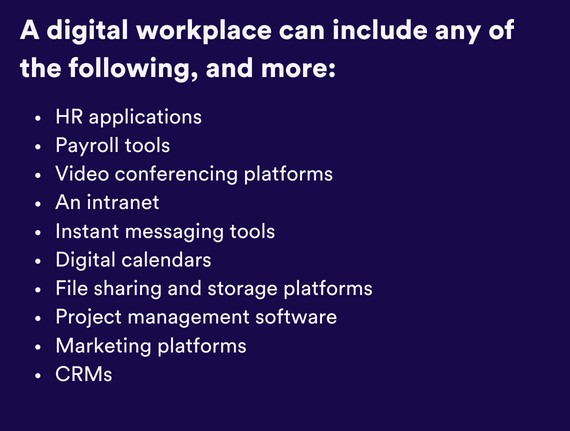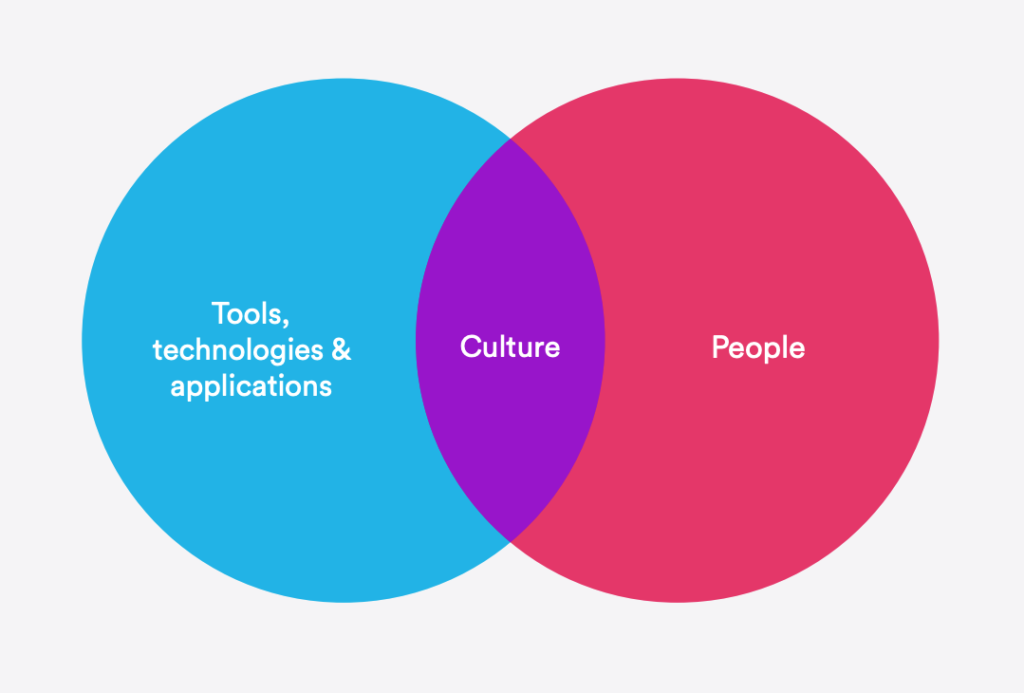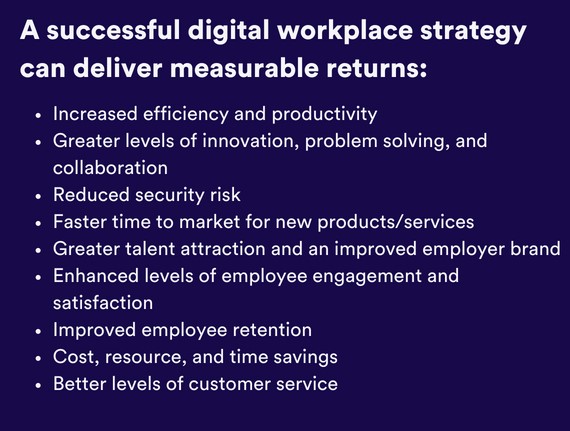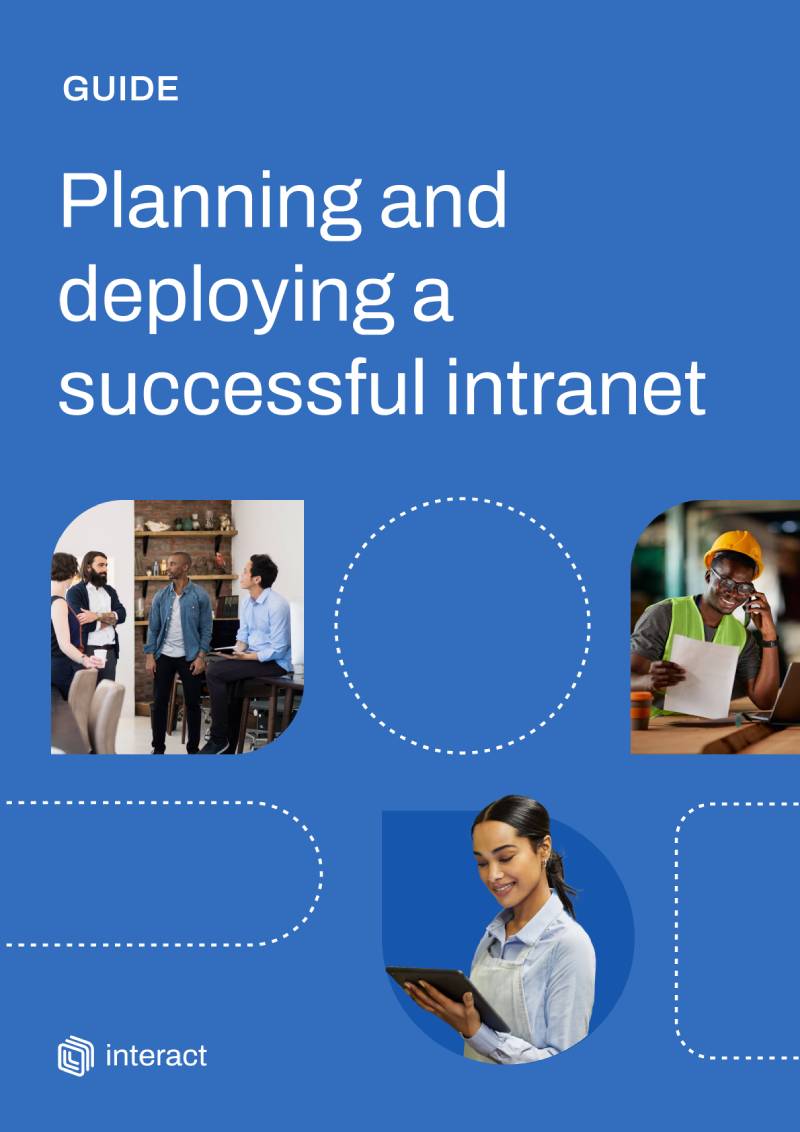The digital workplace is the center of business operations and employee experience, but how exactly do we define it? Is an intranet the same as a digital workplace? And which other enterprise applications should be included? This article helps explain what it means, along with some history and best practices for implementation.
The way we work has shifted dramatically in recent decades, and especially within the past few years. Work is increasingly—and oftentimes entirely—done digitally (the average knowledge worker now uses twice as many apps as they did in 2019). The digital workplace is crucial to productivity, employee experience, and business outcomes. But as our access to digital platforms expands, the concept is becoming blurred. Businesses may be in danger of losing sight of the core functions needed in an effective digital workplace.
So, what is a digital workplace in 2023?
This post will help clear things up, with some background and ways to define a digital workplace, as well as a few things to consider when building one for your organization.
Contents
The evolution of the digital workplace
The early digital workplace
The early digital workplace evolved slowly, beginning with the advent of the digital age. Piece by piece, companies adopted new digital tools, applications, and emerging technologies. It started with the introduction of email and the intranet, and continued with payroll software, CRMs, and HR systems. As technology advanced, our working world gradually became more digital. The shift to the cloud in the early 2000s had a massive impact on the way we work and played a big role in shaping the digital workplace we know today.
As the internet became faster and able to better support the storage and transmission of data, digital workplace transformation, which involves optimizing technology and introducing new solutions to modernize the ways companies do business, became a hot topic.

This timeline shows how the intranet changed over the years—this type of evolution happened in parallel across every aspect of the digital workplace.
Strategic digital workplace transformation programs became commonplace at organizations that recognized the need to adapt. It wasn’t an easy process. Lack of governance, strategy, and ownership created a fragmented, frustrating experience for organizations and employees alike.

Broad digital workplace adoption
The past several years have brought monumental shifts and accelerated the development of the digital workplace. Research from Okta shows that enterprises with over 2,000 employees have an average of 211 business applications within their digital workplaces. And employees continue to work from home, whether occasionally, on a hybrid basis, or full-time.
After a few years of practice, organizations have had time to improve their digital workplaces, although some of the same challenges remain. The digital workplace is here to stay, and more relevant than ever.
Discover how to plan and implement a modern intranet with our complete guide.
The next step: AI and the digital workplace
AI is everywhere. It’s no surprise that it has touched the digital workplace as well, with new tools that increase efficiency for employees and organizations.
There are countless applications for AI in the digital workplace, from audio transcription and task automation to tailored content recommendations for employees.
Implementing these tools can do wonders to free up more time for workers and boost experiences. AI-enabled intranets are another exciting development, allowing internal communicators to connect with employees more easily and effectively.
While the use of generative AI may be the next stage in digital workplace transformation, it also raises some issues around data privacy and security. More companies will need to set AI usage policies to manage this in the future.
What is the digital workplace?
The digital workplace surrounds most of us, but it has no officially agreed-upon definition. However, there are some common themes, ideas, and concepts.
Given the pace of development when it comes to technology, that’s no surprise. The digital workplace as we know it today is different from the one we experienced five years ago. It will be unrecognizable again in another five or ten years.
A basic definition for the digital workplace
The first to define the digital workplace was Paul Miller, in his 2012 book The Digital Workplace: How technology is liberating work. His definition was simple: “the virtual, digital equivalent of the physical workspace.”
According to Miller, the digital workplace encompasses all the digital technologies people use to do their jobs. This includes all platforms, tools, applications, and software. It ranges from HR applications and core business applications to email, instant messaging, social media tools, and virtual meeting tools.

But that’s not all. Another important aspect of the digital workplace are the people who use these tools. In a strategic digital workplace, people and tools come together to create a successful organizational culture.
The digital workplace: Our definition

As a company invested in improving how people work, Interact has considered the definition of the digital workplace a great deal. Our CEO, Simon Dance, sums it up below.
The digital workplace strategically unifies an organization’s employees and the technologies they use in an ecosystem that strives to facilitate agile ways of working, improve employee engagement and deliver an exceptional experience for its users.
Simon Dance – CEO, Interact Software
Discover how to plan and implement a modern intranet with our complete guide.
To break it down, we consider the digital workplace to be made up of three elements: people, tools, and culture.
- People: This category includes everyone who works for an organization, from its CEO to its interns. It encompasses their digital needs and the impact they have on key indicators such as engagement, productivity, and innovation. It also covers the results these employees produce for customers, suppliers, and stakeholders.
- Tools: These are the digital technologies and applications that allow employees to communicate, collaborate, and produce valuable work on a daily basis.
- Culture: When people and tools come together in a strategic way, they collectively shape the employee experience. Aligning the digital experience with a company’s mission, vision, and values makes it a strong foundation for corporate culture and a tool for driving employee engagement.
Is the digital workplace the same as the intranet?
No. Intranet and digital workplace are terms that can get thrown around interchangeably, but they aren’t the same.
Although an organization’s intranet software can have a crucial role in the management of its digital workplace, it’s just one aspect of that ecosystem. Deploying an intranet doesn’t automatically create a robust digital workplace. And it’s even possible to build a successful digital workplace without an intranet at all (although the advantages of an intranet can’t be ignored).
Intranets are powerful tools that are often utilized to build digital workplaces. A strong intranet can serve as a hub. When an organization’s tools, people, and information are scattered in various locations, an intranet can offer a centralized solution. It can become a gateway, the go-to digital destination, and the center of the digital workplace.
Digital workplace benefits
The digital workplace is a core part of your company’s identity. It has a huge impact on the day-to-day lives of your workers and the big-picture success of your organization. When you get strategic about creating a strong digital workplace, you’ll reap the benefits.

Many benefits of a successful digital workplace strategy have to do with efficiency. The easier your employees can find what they need, and the better the tools they have, the more productive they can be.
As a result, your company as a whole saves time and cuts costs. Better collaboration in the digital workplace can result in improved problem solving and innovation, enhancing your offerings and the way you do business. Other advantages are cultural. A thoughtfully designed workplace leads to higher levels of engagement and satisfaction, which boosts employee retention and talent attraction.
How to build a more effective digital workplace
Every organization has different needs, and every digital workplace looks different, which means your company needs to shape your digital workplace to meet your specific objectives.
You likely have a digital workplace already. But is it truly working for employees?
You need to figure out what a successful digital workplace looks like for your business, and what you need to do to achieve it. This may mean going back to the drawing board. Here are some best practices for building a more effective digital workplace.
A holistic approach to the digital workplace
Many digital workplaces arise organically. More and more tools are added to the equation over time, without concern for efficiency or the digital employee experience. This can lead to fragmentation, inefficiency, and disconnection. Creating an effective digital workplace requires a holistic approach.
You’ll need to closely examine your people, your tools, and your culture because building a better digital workplace isn’t as simple as asking staff what they need, buying some new software, and ticking it off the to-do list.
A digital workplace is a conscious and ongoing commitment that requires a long-term vision, governing principles, and consistent performance measurement.
Questions to ask when building a digital workplace strategy
Designing a digital workplace strategy doesn’t have to be overwhelming. You can start by asking the right questions. As part of the process, you’ll need to consider the following:
Discover how to plan and implement a modern intranet with our complete guide.
- Who are our employees and what do they need to do their jobs well?
- What technologies already make up our digital workplace and what overlaps could we eliminate?
- Where are there gaps between employee needs and the tools available to them?
- Can every employee connect to the information and tools they need, regardless of their device type or location?
- Do our employees understand our organization, its direction and purpose, and how they contribute to the achievement of its goals?
- Do our systems integrate or work together effectively? For example, do we signpost access to line of business (LOB) apps from the homepage of the intranet?
- Are we leveraging an effective intranet solution that gives our employees a central access point to our digital workplace?
- How do people rate the digital employee experience currently?
- What do we envision for the future of our digital workplace?
- How does our digital workplace align with, or contribute to, our organization’s mission, objectives, and overall culture?
Employees and the digital workplace
The questions above aren’t just for management. Listening to employees is essential for making sure your digital workplace works for your users. Understanding the people in your digital workplace will help you choose the right tools and build a strong company culture.
Like all other aspects of a building a successful workforce, listening isn’t a one-time exercise. Make it a point to regularly survey your employees and include questions that assess their sentiments about the digital workplace. Technology is always evolving, and there may be new needs or solutions that could make the employee experience a whole lot better.


